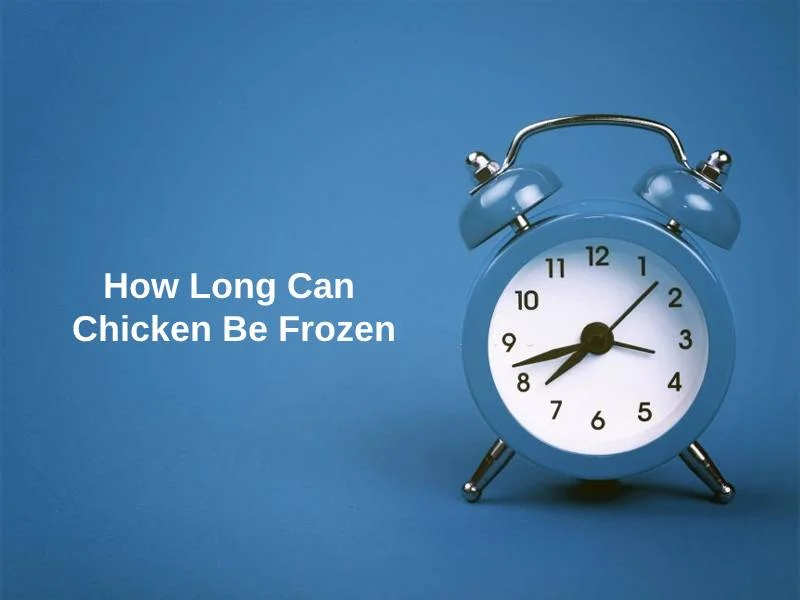Exact Answer: 1 To 12 Months
Freezing fresh or cooked chicken is the best way to combat food wastage and keep plenty of chicken on hand for an extended period. One can efficiently do so by thoroughly wrapping the meat in plastic, followed by a layer of foil or an airtight freezer bag.
When freezing chicken, one must keep in mind two things. Firstly, freeze the fresh meat immediately after purchasing it. Secondly, store the chicken in a freezer that is zero degrees Fahrenheit or lower. Frozen uncooked chicken has a shelf life of one to 12 months, depending on its cut and size.

How Long Can Chicken Be Frozen?
Three factors determine how long chicken will last in a freezer. They are temperature, size of the meat and whether it is cooked or uncooked.
Properly packaged, frozen chicken meat kept at 0 degrees Fahrenheit is good for up to 12 months. Poultry stored at 10 degrees Fahrenheit will remain in good condition for six months, and meat kept at 20 degrees Fahrenheit will last for three months. A point to note is that chicken meat does not freeze until it is around 26 degrees Fahrenheit, as they contain high amounts of fat and protein.
The size of the chicken meat decides how long one can store it in a freezer. One can store a whole raw chicken in the freezer for one year, parts for nine months and giblets or ground chicken for three to four months if kept frozen continuously. These meats spoil fast if they are repeatedly frozen and thawed.
Cooked chicken, however, can not be stored for so long. Cooked meats taste best if kept frozen for up to four months. A cooked chicken casserole or gravy will last six months, and chicken nuggets or patties are good for one to three months.
One must remember to use plastic bags or containers to freeze meat as glass jars, produce bags or wax paper are not airtight or thick. Additionally, one must not store meat for longer than mentioned.
In summary,
| Type Of Chicken | Time It Can Be Frozen For |
| Whole chicken | 12 months |
| Parts of chicken | Six months |
| Giblets or ground chicken | Three to four months |
| Cooked chicken | Four months |
| Chicken casserole or gravy | Six months |
| Chicken nuggets or patties | One to three months |
Why Can Chicken Be Frozen For So Long?
When chicken is frozen, ice crystals form, which helps maintain the cellular structure and texture of the meat when thawed. Furthermore, the low temperatures massively slow down the ability of microorganisms to reproduce, hence keeping the food fresh for longer.
At zero degrees Fahrenheit, the growth of microorganisms like bacteria, yeast, and mold completely stops. However, at 10 or 20 degrees, that is not the case. Microbes may grow at higher temperatures, so the chicken will only last three to six months versus the 12 months at zero degrees.
Another thing to remember is that frozen raw chicken can be stored for 12 months only if frozen continuously. Repeated freeze-thawing of chicken can increase chances of contamination and bacteria growth, hence reducing its shelf life. Furthermore, this fluctuating temperature results in larger ice crystals that damage cells creating a mushier product. Hence, one must store meat in smaller parts to increase its shelf life and obtain quality meat on thawing.
Storing chicken meat for longer than the appropriate mentioned time can lead to three outcomes. Firstly, the thawed and cooked chicken meat will be dry. Secondly, chicken meat may become rancid as the cells contain a high concentration of minerals, and thirdly, the occurrence of freezer burn, making the food unpleasant to eat.
Conclusion
Freezing meat is a sure shot way to prevent food wastage. Although this process sounds simple, it is not. Factors like temperature, size of the meat, and repeated freeze-thawing determine how long one can store the chicken meat.
Hence, to ensure optimum shelf-life, one must store the meat at zero degrees Fahrenheit in smaller portions to prevent the growth of bacteria and other microorganisms like yeast and mold.